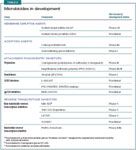Vaginal microbicides: What does the future hold?
New antimicrobial agents that hold promise against HIV and other sexually transmitted diseases are now being tested. Agents include Acidform, BufferGel and dapivirine.

Key Points

Our goal here is to review the various microbicides currently being tested, outlining their mechanism of action, potential usefulness, and safety profile.
A spermicide with little or no microbicidal properties
Unfortunately research proved the agent less than ideal.3 Beginning in 1990, randomized controlled trials compared different N-9 formulations-sponge, film, and various gels-and dosages3-7 for their efficacy against HIV and other STDs. Taken together, these studies showed little if any protection against HIV, gonorrhea, and chlamydia. In one trial, women who used N-9 gel actually had higher rates of HIV than women using placebo gel.8
How do microbicides work?

Another polyanion gel-Pro2000/5-is currently being evaluated in large-scale effectiveness trials, which should have evidence within a year. The higher dose arm (2%) of Pro2000/5 was halted in February because the data could not show it was effective. The lower dose (0.5%) is continuing to be evaluated in two separate trials. Pro2000/5 may also have contraceptive activity. Another potential group of contraceptives, dendrimers, such as VivaGel, are highly branched macromolecules that also prevent HIV from attaching to the target cells.10 VivaGel is currently in safety studies.
While polyanions are nonspecific in the way they work, several HIV-specific entry/fusion inhibitors are also in development as microbicides, including drugs that block gp-41 fusions and CCR5-receptor binding.
